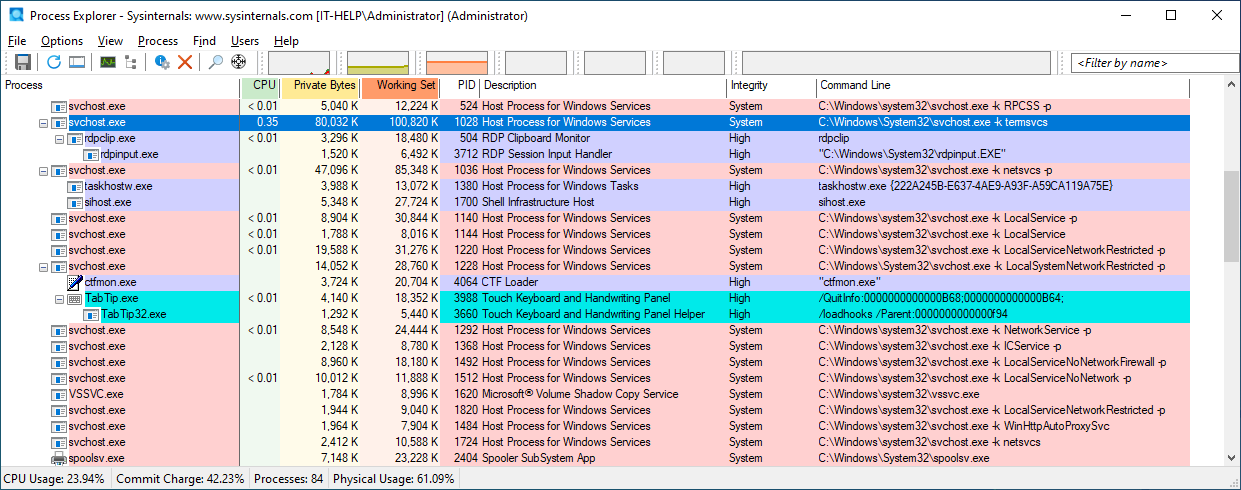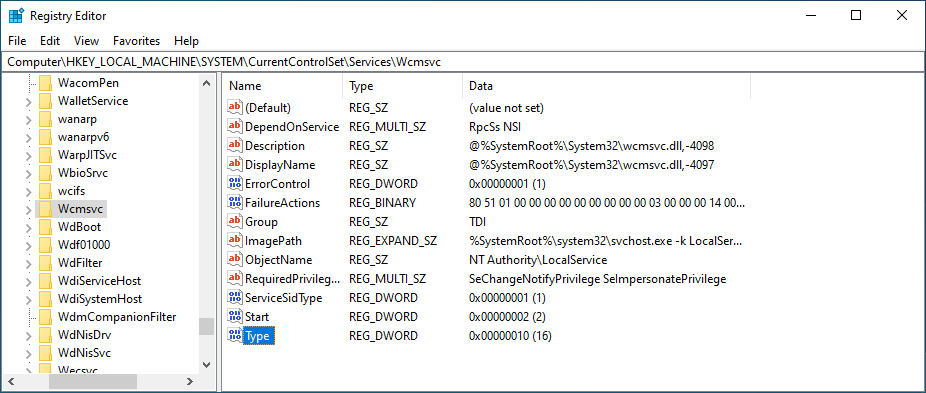Isolating a Windows Service Process for Easier Debugging
Have you ever wanted to identify which process hosts a specific system service, only to realize that they all show up as "svchost.exe" in Process Monitor or Process Explorer?

Some system services like TermService (Remote Desktop Services) leave some obvious clues like a child "rdpclip.exe" process. However, most of the time, you won't be so lucky.
Finding the Service Process Id
The most accurate method to find the process id matching a system service is through WMI. Here's a simple Get-ServiceProcessId PowerShell cmdlet you can paste and use wherever needed:
function Get-ServiceProcessId {
[CmdletBinding()]
param (
[Parameter(Mandatory, ValueFromPipelineByPropertyName)]
[string] $Name
)
process {
$svc = Get-CimInstance Win32_Service -Filter "Name='$Name'"
if ($svc -and ($svc.ProcessId -ne 0)) {
$svc.ProcessId
}
}
}
You can try it out with the Diagnostic Process Service (DPS), which should be in the running state on most systems:
PS> Get-ServiceProcessId DPS
6340
Get-Service DPS | Get-ServiceProcessId
6340
Neat! Now you can use the process id to filter events in Process Monitor and learn more what a specific services does.
Finding the Service Group Name
Ah ha! You thought this was the end of it, didn't you? Unfortunately, you may notice that many system services share the same svchost.exe process. Uh oh - that's not good if you want to filter on a specific service. This is a side effect of service groups, a feature used to pool multiple services together for performance reasons. You can use the Get-ServiceGroupName PowerShell cmdlet to find the optional service group name associated with a service:
function Get-ServiceGroupName {
[CmdletBinding()]
param (
[Parameter(Mandatory, ValueFromPipelineByPropertyName)]
[string] $Name
)
process {
$svc = Get-CimInstance Win32_Service -Filter "Name='$Name'"
if ($svc) {
if ($svc.PathName -match '-k\s+(\w+)') {
$matches[1]
}
}
}
}
How does it work? Members of a service group register svchost.exe as their executable and pass the service group name in the -k command-line parameter. When the Service Control Manager (SCM) sees this parameter, it will launch a single process for all members of the same group. Let's try it with a few system services:
PS> Get-ServiceGroupName DPS
LocalServiceNoNetwork
PS> Get-ServiceGroupName WinHttpAutoProxySvc
LocalServiceNetworkRestricted
LocalServiceNoNetwork and LocalServiceNetworkRestricted are built-in service groups in Windows. There are several others which I'll let you discover on your own.
Finding Service Group Members
Now that we know the service group name for the service of interest, how can we find other members of the same group? Luckily for us, service group membership is stored as a list in the registry:

Here's the Get-ServiceGroupMembers PowerShell cmdlet that simplifies obtaining service group members:
function Get-ServiceGroupMembers {
[CmdletBinding()]
param (
[Parameter(Mandatory, ValueFromPipeline)]
[string] $GroupName
)
try {
$SvchostRegPath = 'HKLM:\SOFTWARE\Microsoft\Windows NT\CurrentVersion\Svchost'
Get-ItemProperty -Path $SvchostRegPath | Select-Object -ExpandProperty $GroupName -ErrorAction Stop
}
catch {
Write-Error "Group '$GroupName' not found in svchost registry."
}
}
The LocalServiceNoNetwork service group contains just a few services:
PS> Get-ServiceGroupMembers LocalServiceNoNetwork
DPS
PLA
CoreMessagingRegistrar
NcdAutoSetup
The LocalServiceNetworkRestricted service group, on the other hand, is quite big:
Get-ServiceGroupMembers LocalServiceNetworkRestricted
TimeBrokerSvc
WarpJITSvc
eventlog
AudioSrv
WinHttpAutoProxySvc
wscsvc
LmHosts
AppIDSvc
WFDSConMgrSvc
vmictimesync
btagservice
SmsRouter
NgcCtnrSvc
icssvc
RmSvc
wlpasvc
DusmSvc
DHCP
wcmsvc
If you were hoping to learn more about one of those services, this can make your work harder.
Moving Service to a New Group
Welcome to the danger zone: for this last part, please use a test virtual machine, as we're going to be fiddling with service registrations, and there is a potential to break things.
How can one isolate a system service such that it can run in its own process without other services in it? Service groups are not mandatory, but modifying a service registration to not use a service group can be difficult. The simplest approach is to create a new service group similar to the original one, and move the service of interest into it. Hold your breath for the Move-ServiceToNewGroup PowerShell cmdlet:
function Move-ServiceToNewGroup {
[CmdletBinding()]
param (
[Parameter(Mandatory, Position = 0)]
[string] $ServiceName,
[Parameter(Mandatory, Position = 1)]
[string] $OldGroupName,
[Parameter(Mandatory, Position = 2)]
[string] $NewGroupName
)
$SvchostRegPath = 'HKLM:\SOFTWARE\Microsoft\Windows NT\CurrentVersion\Svchost'
$ServiceRegPath = "HKLM:\SYSTEM\CurrentControlSet\Services\$ServiceName"
# Remove from old service group
$OldGroupMembers = Get-ItemProperty -Path $SvchostRegPath | Select-Object -ExpandProperty $OldGroupName -ErrorAction Stop
$OldGroupMembers = $OldGroupMembers | Where-Object { $_ -ne $ServiceName }
Set-ItemProperty -Path $SvchostRegPath -Name $OldGroupName -Value $OldGroupMembers
# Add to new service group
$NewGroupMembers = Get-ItemProperty -Path $SvchostRegPath -Name $NewGroupName -ErrorAction SilentlyContinue
if (-Not $NewGroupMembers) {
$NewGroupMembers = @($ServiceName)
New-ItemProperty -Path $SvchostRegPath -Name $NewGroupName -PropertyType MultiString -Value $NewGroupMembers | Out-Null
} else {
$NewGroupMembers = $NewGroupMembers | Select-Object -ExpandProperty $NewGroupName
$NewGroupMembers = @($NewGroupMembers) + $ServiceName
$NewGroupMembers = $NewGroupMembers | Sort-Object -Unique
Set-ItemProperty -Path $SvchostRegPath -Name $NewGroupName -Value $NewGroupMembers
}
# Update ImagePath with -k parameter (group name) passed to svchost.exe
$ImagePath = Get-ItemPropertyValue -Path $ServiceRegPath -Name ImagePath -ErrorAction Stop
$ImagePath = $ImagePath -Replace "\s*-k\s+$OldGroupName", " -k $NewGroupName"
Set-ItemProperty -Path $ServiceRegPath -Name ImagePath -Value $ImagePath
# Copy service group configuration values
$OldGroupConfig = "HKLM\SOFTWARE\Microsoft\Windows NT\CurrentVersion\Svchost\$OldGroupName"
$TempReg = Join-Path $Env:TEMP "svchost-$NewGroupName.reg"
reg export "$OldGroupConfig" "$TempReg" /y | Out-Null
(Get-Content $TempReg) -replace "\\$OldGroupName", "\\$NewGroupName" | Set-Content $TempReg
reg import "$TempReg" | Out-Null
Remove-Item $TempReg -Force
}
Yes, it's a lot more complicated than the previous cmdlets. Let's just try it with WinHttpAutoProxySvc, the Windows Proxy Auto Detect (WPAD) service in Windows. It is a member of the LocalServiceNetworkRestricted service group, but we'll move it to a new service group matching its own name (WinHttpAutoProxySvc). Run this command from an elevated PowerShell terminal:
PS> Move-ServiceToNewGroup WinHttpAutoProxySvc LocalServiceNetworkRestricted WinHttpAutoProxySvc
If everything worked, you just need to reboot the virtual machine. Avoid manually starting or stopping this service - other services depend on it, and it may behave as unexpectedly. If you look in the registry, you should now see the new service group configuration under HKEY_LOCAL_MACHINE\SOFTWARE\Microsoft\Windows NT\CurrentVersion\Svchost\WinHttpAutoProxySvc:

The service configuration under HKEY_LOCAL_MACHINE\SYSTEM\CurrentControlSet\Services\WinHttpAutoProxySvc should also have a new value for ImagePath:

Now make sure that the WinHttpAutoProxySvc service is running:
PS> Get-Service WinHttpAutoProxySvc | Format-List
Name : WinHttpAutoProxySvc
DisplayName : WinHTTP Web Proxy Auto-Discovery Service
Status : Running
DependentServices : {NcaSvc, iphlpsvc}
ServicesDependedOn : {Dhcp}
CanPauseAndContinue : False
CanShutdown : True
CanStop : False
ServiceType : Win32ShareProcess
PS> Get-ServiceProcessId WinHttpAutoProxySvc
1484
Last but not least, let's confirm that none of the other services in the original service group have a matching process id:
PS> Get-ServiceGroupMembers LocalServiceNetworkRestricted | ForEach-Object {
[PSCustomObject]@{ ServiceName = $_; ProcessId = Get-ServiceProcessId $_ }
}
ServiceName ProcessId
----------- ---------
TimeBrokerSvc 1220
WarpJITSvc
eventlog 1220
AudioSrv
LmHosts 1220
AppIDSvc
vmictimesync 1220
NgcCtnrSvc
RmSvc
wcmsvc 1820
DHCP 1220
AJRouter
Success! None of the running services share the same process.
Taking a Shortcut I Wish I Knew Earlier
The most observant of you will have noticed that the wcmsvc service has a different process id despite being a member of the LocalServiceNetworkRestricted service group. How can that be? Let's look at the wcmsvc service more closely:
PS> Get-Service wcmsvc | Format-List
Name : wcmsvc
DisplayName : Windows Connection Manager
Status : Running
DependentServices : {}
ServicesDependedOn : {RpcSs, NSI}
CanPauseAndContinue : False
CanShutdown : True
CanStop : True
ServiceType : Win32OwnProcess
A service type of Win32OwnProcess, despite being a member of a service group? Does that mean one can just change this service type instead of moving the service to a new service group? Let's look in the registry:

The WinHttpAutoProxySvc service has a type of Win32ShareProcess with corresponding value of 32 in the registry. Let's just change that to Win32OwnProcess with a value of 16 instead:
function Set-ServiceTypeOwnProcess {
[CmdletBinding()]
param (
[Parameter(Mandatory, Position = 0)]
[string] $ServiceName
)
$ServiceRegPath = "HKLM:\SYSTEM\CurrentControlSet\Services\$ServiceName"
Set-ItemProperty -Path $ServiceRegPath -Name "Type" -Value 16 -Type DWORD
}
Set-ServiceTypeOwnProcess "WinHttpAutoProxySvc"
Run this on a machine where the service hasn't been moved to a different group, then reboot. List process ids for all services in the LocalServiceNetworkRestricted group:
PS> Get-ServiceGroupMembers LocalServiceNetworkRestricted | ForEach-Object {
[PSCustomObject]@{ ServiceName = $_; ProcessId = Get-ServiceProcessId $_ }
}
ServiceName ProcessId
----------- ---------
TimeBrokerSvc 1072
WarpJITSvc
eventlog 1072
AudioSrv
WinHttpAutoProxySvc 1920
LmHosts 1072
AppIDSvc
vmictimesync 1072
NgcCtnrSvc
RmSvc
wcmsvc 1960
DHCP 1072
AJRouter
Congratulations, it worked! The WinHttpAutoProxySvc service is still a member of the LocalServiceNetworkRestricted, but it is now running in its own isolated process. This is obviously much simpler, and can be done manually with regedit.exe.
Disabling Service Host Process Pooling
The SvcHostSplitThresholdInKB registry key value under HKEY_LOCAL_MACHINE\SYSTEM\CurrentControlSet\Control can be used to disable svchost.exe process pooling entirely. By default, the threshold is set to 3670016 (0x380000) KB, which corresponds to approximately 3.5 GB of RAM:

If your system has more memory than the configured threshold, separate svchost.exe processes will be created for all services, including those with the Win32ShareProcess service type. If you have limited RAM in a test virtual machine, the threshold will be too high. Set the SvcHostSplitThresholdInKB value to 1 and to disable service host process pooling:
Set-ItemProperty -Path 'HKLM:\SYSTEM\CurrentControlSet\Control' -Name 'SvcHostSplitThresholdInKB' -Value 1
Don't set SvcHostSplitThresholdInKB to 0 as it appears to be treated as a special value that doesn't do what we want. After rebooting, confirm that the change had the intended side effect:
PS> Get-ServiceGroupMembers LocalServiceNetworkRestricted | ForEach-Object {
[PSCustomObject]@{ ServiceName = $_; ProcessId = Get-ServiceProcessId $_ }
}
ServiceName ProcessId
----------- ---------
TimeBrokerSvc 1360
WarpJITSvc
eventlog 1340
AudioSrv
WinHttpAutoProxySvc 2640
LmHosts 1184
AppIDSvc
vmictimesync 1720
NgcCtnrSvc
RmSvc
wcmsvc 2448
DHCP 1412
AJRouter
This is yet another trick I wish I knew earlier, and is much simpler to work with!
Closing Thoughts
Being able to isolate a system service into its own process is incredibly useful when you're trying to understand what it actually does. Whether you go the long route by creating a new service group or take the shortcut by switching the service type to Win32OwnProcess, the end result is the same: less background noise, cleaner traces, and a much easier time in tools like Process Monitor.